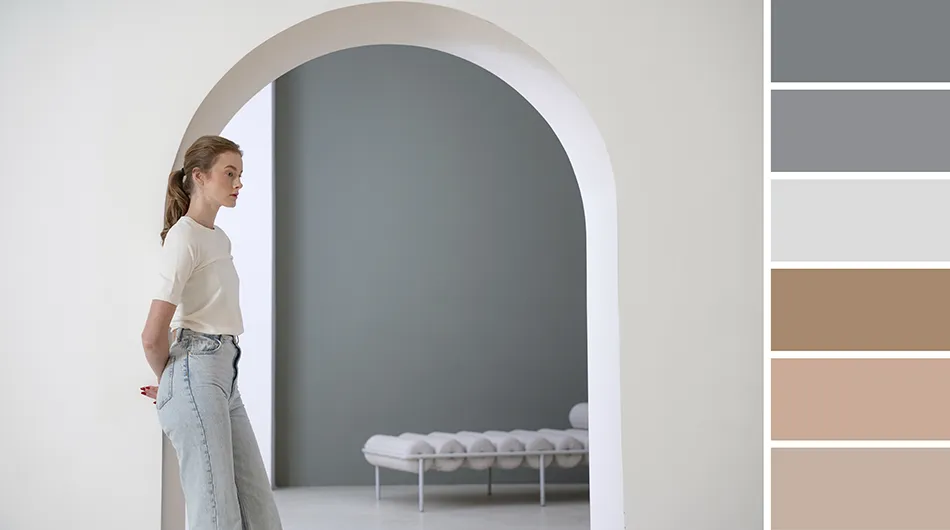
Expert Advice on Finding the Perfect Paint Colors for Every Room
Choosing the right paint colors for your home can feel like a big decision. With thousands of shades, hues, and finishes to choose from, where do you start? Whether you’re refreshing one room or remodeling your entire house, the colors you pick have a huge impact on the overall look and feel of your space. In this comprehensive guide, we’ll walk you through expert tips and strategies for selecting the perfect paint colors that not only suit your style but also work well with your space and lighting.
Understanding Your Space: How Room Size Affects Paint Colors
The first step in choosing the right paint colors is to understand the space you’re working with. The size and shape of your room will influence how colors look. Here’s how different types of rooms respond to paint colors:
1. Small Spaces: Opt for Lighter Shades
Smaller rooms tend to feel cramped with dark colors, as dark shades absorb light and can make a space feel closed off. Instead, go for lighter shades like soft whites, pastels, or light grays to create the illusion of more space. These colors reflect light and can make a room feel larger and airier.
- Pro Tip: Consider using mirrors along with lighter shades to enhance the feeling of space.
2. Large Spaces: Add Warmth with Darker Tones
In larger rooms, dark colors can make a room feel cozier and more intimate. If you have a spacious living room or open-plan area, deep colors like navy blue, charcoal, or forest green can add depth and warmth.
3. Multi-Functional Rooms: Choose Flexible Neutrals
For open-plan spaces or multi-functional rooms, neutral colors like beige, gray, or taupe are ideal. These shades work well with a variety of furniture styles and accent colors, giving you flexibility to change up your decor without repainting.
The Role of Lighting: How Light Affects Paint Colors
Lighting plays a major role in how paint colors appear in your home. A color that looks great in a showroom might look entirely different in your living room due to the type of lighting in the space. Here’s how to take lighting into account when choosing paint colors:
1. Natural Light
Natural light changes throughout the day, so the way a paint color looks in the morning could be different by afternoon or evening. Rooms with lots of windows and natural light allow paint colors to show their true shades.
- North-facing rooms: Cool natural light can make colors appear slightly muted. To counteract this, opt for warm tones like creamy whites, yellows, or warm grays.
- South-facing rooms: These rooms benefit from warm, bright natural light all day, so both light and dark colors will work well. Just be sure to test your chosen shade at different times of the day to see how it holds up.
2. Artificial Light
In spaces with limited natural light, artificial lighting becomes critical. The type of light bulbs you use can drastically change how paint colors appear.
- Warm bulbs: These tend to cast a yellowish light, making warm colors feel even cozier. However, cool tones may appear dull under warm bulbs.
- Cool bulbs: These bulbs give off a bluish light, which can make whites, grays, and other cool tones feel crisp and clean.
Neutrals as a Safe Starting Point
If you’re feeling overwhelmed by the sheer number of paint color options, starting with neutral tones is a great way to keep things simple. Neutrals are versatile and easy to pair with just about any style of decor, allowing you to change up your accent pieces without having to repaint.
1. Beige and Creams for a Cozy Vibe
Beige and creams are timeless options that can add warmth to a room without overwhelming the space. These colors are perfect for living rooms and bedrooms, offering a cozy yet refined atmosphere.
2. Cool Grays for a Modern Look
Gray has become one of the most popular neutral colors for modern homes. Cool grays can add a sleek, sophisticated touch to your space, especially when paired with minimalist furniture and decor. For a more playful look, consider accenting with bright-colored pillows, rugs, or artwork.
3. White for a Clean, Fresh Aesthetic
White is a classic neutral that works in any room. It reflects light well, making it ideal for smaller spaces or rooms with limited natural light. However, be mindful of the undertones in white paints. Some whites have cool undertones (which can look bluish), while others have warm undertones (which can appear creamy).
Using Color to Set the Mood
Paint colors can evoke certain feelings and set the tone for each room in your home. Here’s how to choose colors based on the mood you want to create:
1. Calm and Relaxing
For spaces where you want to unwind, like bedrooms or bathrooms, consider soft, cool tones like pale blues, greens, or lavenders. These colors are soothing and can help promote relaxation and sleep.
2. Energizing and Vibrant
Rooms like kitchens, home offices, and playrooms benefit from vibrant colors that energize and uplift. Bright yellows, reds, and oranges can create a lively atmosphere that helps boost productivity and energy.
3. Warm and Cozy
If you’re aiming for warmth and coziness in your living room or dining room, opt for rich tones like deep reds, oranges, or browns. These colors make a room feel intimate and inviting.
Common Mistakes to Avoid When Choosing Paint Colors
Even with all the best intentions, choosing the wrong paint color can be frustrating. Here are some common mistakes to avoid:
1. Ignoring the Room’s Lighting
As mentioned earlier, lighting plays a big role in how a color looks. Always test a paint color in the room before committing. Paint swatches in different areas and see how they change throughout the day under both natural and artificial light.
2. Overlooking the Room’s Purpose
Make sure the paint color aligns with the function of the room. For example, a vibrant red might be great for a dining room, but it could be too stimulating for a bedroom where you’re trying to relax.
3. Not Considering the Flow Between Rooms
If your rooms are interconnected, make sure the colors complement each other to create a cohesive look. Colors that clash can make your home feel disjointed and chaotic.
4. Going Too Bold Too Fast
While bold colors can be fun, it’s best to start with small accents rather than painting an entire room in a bold hue. Consider using bold colors for an accent wall or decorative elements before fully committing.
Testing Paint Colors: The Key to Avoiding Regret
The best way to ensure you’re choosing the right color is by testing it out. Purchase sample sizes of the colors you’re considering and paint large swatches on different walls in the room. Here’s how to do it right:
1. Paint Large Test Areas
Small swatches won’t give you a true sense of how the color will look. Instead, paint large test areas (about 2×2 feet) on multiple walls to see how the color reacts to light.
2. Observe the Color at Different Times of Day
Since natural light changes throughout the day, be sure to observe the test areas in the morning, afternoon, and evening to see how the color shifts. This will give you a better idea of what to expect once the entire room is painted.
Conclusion
Choosing the right paint colors for your home doesn’t have to be stressful. By understanding your space, considering lighting, and testing colors before committing, you can find the perfect shades to transform your home. Remember, it’s not just about following trends but selecting colors that reflect your style and create a comfortable atmosphere in every room.
Need expert help selecting the perfect paint colors?
Contact ROi Home Remodeling in El Paso, Texas, today! Our experienced team will help you choose colors that suit your home and style.
Call us at (915) 615-7642 or visit Book a Discovery Meeting to get started


